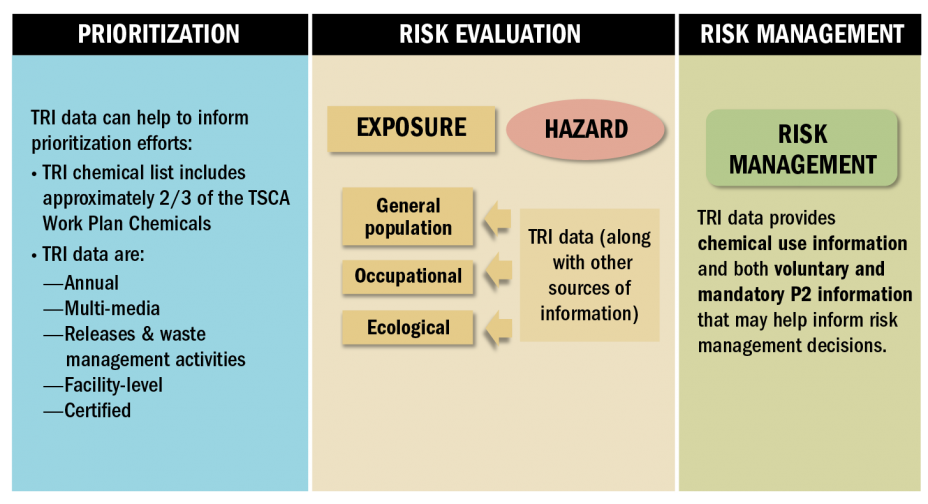TSCA and TRI
This section highlights how TRI information contributes to data used in Toxics Substances Control Act (TSCA) risk evaluations. TRI data serve as a source of environmental information for TSCA throughout the three-stage chemical evaluation process. TSCA, as amended by the Frank R. Lautenberg Chemical Safety for the 21st Century Act, is the nation’s primary chemicals management law. TSCA requires EPA to evaluate existing chemicals in commerce and new chemicals intended for use in commerce for safety. The Agency is required to conduct a transparent, risk-based process. EPA selects existing chemicals for further evaluation from the 2014 Update to the TSCA Work Plan, which helps to focus and direct EPA’s activities.
The three stages of EPA’s process for evaluating the safety of existing chemicals are prioritization, risk evaluation, and risk management. EPA first prioritizes toxic chemicals in commerce through a screening-level review, evaluates those chemicals to determine if they present unreasonable risks, and then manages the unreasonable risks of those chemicals to protect human health and the environment. During both the prioritization and risk evaluation stages of the process, TRI serves as a source of information as illustrated in the figure below. TRI data may also be used in the risk management stage of the process.

Prioritization. Approximately two-thirds of the chemicals identified in the 2014 update of the TSCA Work Plan are also included on the TRI list of chemicals. TRI data can inform EPA’s prioritization of chemicals for risk evaluation because the data are collected annually and include the location of facilities and the quantities of TRI chemicals they released to air, water and land, and transferred to off-site locations. In addition, trend analyses of TRI data can help identify changes over time in the geographic location and quantities of releases, and the types of industrial sectors managing these chemicals.
Risk evaluation. A TSCA risk evaluation of a chemical is a comprehensive evaluation of the risks the chemical poses to human health and the environment. EPA evaluates how the chemical will be used, which may include manufacturing and import, processing, use, distribution in commerce, and disposal over the chemical’s life cycle. During risk evaluation, EPA is required to assess exposures to the chemical in the workplace, to the general population and to environmental (e.g. ecological) receptors. This includes assessment of potentially exposed or susceptible populations that may be sensitive to the potential hazards posed by the chemical under review. TRI and other data are used to support these assessments under TSCA.
Risk Management. If EPA determines that a chemical poses an unreasonable risk of injury to health or the environment under its methods of use, EPA will impose regulatory actions or other risk management options to effectively manage the identified risk. These regulatory actions and options may include labeling with warnings and instructions for use, recordkeeping or notice requirements, restrictions on certain uses or activities to reduce human exposure or environmental releases, or a ban of the chemical entirely. EPA may use TRI data, such as on chemical use and pollution prevention practices, to help inform these risk management decisions.
High-priority Substances for TSCA Risk Evaluation
In 2017, EPA published the scope documents for the initial ten chemicals undergoing risk evaluation under the amended TSCA in which nine of the ten chemicals are TRI-reportable chemicals (except for C.I. Pigment Violet 29).
In 2019, EPA announced the next 20 chemicals to undergo risk evaluation. Finalizing this list of high-priority chemicals for risk evaluation establishes the TSCA prioritization queue which requires ongoing review and selection of priority chemicals as evaluations are completed. This marks a major milestone for EPA in its efforts to ensure the safety of existing chemicals in the marketplace through its updated chemical management program. In August 2020, EPA published the final scope documents for these 20 chemical substances, of which 13 are TRI-reportable chemicals.
This page was published in January 2021 and uses the 2019 TRI National Analysis dataset made public in TRI Explorer in October 2020.
